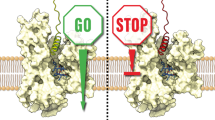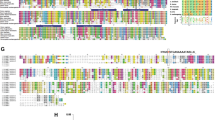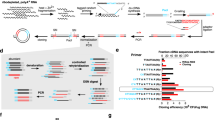Abstract
Cotransins target the Sec61 translocon and inhibit the biogenesis of an undefined subset of secretory and membrane proteins. Remarkably, cotransin inhibition depends on the unique signal peptide (SP) of each Sec61 client, which is required for cotranslational translocation into the endoplasmic reticulum. It remains unknown how an SP’s amino acid sequence and biophysical properties confer sensitivity to structurally distinct cotransins. Here we describe a fluorescence-based, pooled-cell screening platform to interrogate nearly all human SPs in parallel. We profiled two cotransins with distinct effects on cancer cells and discovered a small subset of SPs, including the oncoprotein human epidermal growth factor receptor 3 (HER3), with increased sensitivity to the more selective cotransin, KZR-9873. By comparing divergent mouse and human orthologs, we unveiled a position-dependent effect of arginine on SP sensitivity. Our multiplexed profiling platform reveals how cotransins can exploit subtle sequence differences to achieve SP discrimination.

This is a preview of subscription content, access via your institution
Access options
Access Nature and 54 other Nature Portfolio journals
Get Nature+, our best-value online-access subscription
$29.99 / 30 days
cancel any time
Subscribe to this journal
Receive 12 print issues and online access
$259.00 per year
only $21.58 per issue
Buy this article
- Purchase on Springer Link
- Instant access to full article PDF
Prices may be subject to local taxes which are calculated during checkout






Similar content being viewed by others
Data availability
The data supporting this study are available within the paper and its Extended Data and Supplementary Information files. Raw data files needed in other formats are available from the corresponding author upon reasonable request. The public databases, UniProt and Ensembl, were used in this study. Source data are provided with this paper.
References
Shao, S. & Hegde, R. S. Membrane protein insertion at the endoplasmic reticulum. Annu. Rev. Cell Dev. Biol. 27, 25–56 (2011).
Egea, P. F., Stroud, R. M. & Walter, P. Targeting proteins to membranes: structure of the signal recognition particle. Curr. Opin. Struct. Biol. 15, 213–220 (2005).
Voorhees, R. M. & Hegde, R. S. Toward a structural understanding of co-translational protein translocation. Curr. Opin. Cell Biol. 41, 91–99 (2016).
Rapoport, T. A., Li, L. & Park, E. Structural and mechanistic insights into protein translocation. Annu. Rev. Cell Dev. Biol. 33, 369–390 (2017).
Liaci, A. M. et al. Structure of the human signal peptidase complex reveals the determinants for signal peptide cleavage. Mol. Cell. 81, 3934–3948 (2021).
Blobel, G. & Dobberstein, B. Transfer of proteins across membranes. I. Presence of proteolytically processed and unprocessed nascent immunoglobulin light chains on membrane-bound ribosomes of murine myeloma. J. Cell Biol. 67, 835–851 (1975).
Von Heijne, G. Signal sequences: the limits of variation. J. Mol. Biol. 184, 99–105 (1985).
Teufel, F. et al. SignalP 6.0 predicts all five types of signal peptides using protein language models. Nat. Biotechnol. 40, 1023–1025 (2022).
Nielsen, H., Tsirigos, K. D., Brunak, S. & von Heijne, G. A brief history of protein sorting prediction. Protein J. 38, 200–216 (2019).
Voorhees, R. M. & Hegde, R. S. Structure of the Sec61 channel opened by a signal sequence. Science 351, 88–91 (2016).
Hegde, R. S. & Kang, S. W. The concept of translocational regulation. J. Cell Biol. 182, 225–232 (2008).
Besemer, J. et al. Selective inhibition of cotranslational translocation of vascular cell adhesion molecule 1. Nature 436, 290–293 (2005).
Garrison, J. L., Kunkel, E. J., Hegde, R. S. & Taunton, J. A substrate-specific inhibitor of protein translocation into the endoplasmic reticulum. Nature 436, 285–289 (2005).
Meyer, L. K. et al. Inhibition of the Sec61 translocon overcomes cytokine-induced glucocorticoid resistance in T-cell acute lymphoblastic leukemia. Br. J. Haematol. 198, 137–141 (2022).
Rehan, S. et al. Signal peptide mimicry primes Sec61 for client-selective inhibition. Nat. Chem. Biol. 19, 1054–1062 (2023).
MacKinnon, A. L., Garrison, J. L., Hegde, R. S. & Taunton, J. Photo-leucine incorporation reveals the target of a cyclodepsipeptide inhibitor of cotranslational translocation. J. Am. Chem. Soc. 129, 14560–14561 (2007).
Maifeld, S. V. et al. Secretory protein profiling reveals TNF-α inactivation by selective and promiscuous sec61 modulators. Chem. Biol. 18, 1082–1088 (2011).
Mackinnon, A. L. et al. An allosteric Sec61 inhibitor traps nascent transmembrane helices at the lateral gate. eLife 3, e01483 (2014).
Harant, H. et al. The translocation inhibitor CAM741 interferes with vascular cell adhesion molecule 1 signal peptide insertion at the translocon. J. Biol. Chem. 281, 30492–30502 (2006).
Harant, H. et al. Inhibition of vascular endothelial growth factor cotranslational translocation by the cyclopeptolide CAM741. Mol. Pharmacol. 71, 1657–1665 (2007).
Itskanov, S. et al. A common mechanism of Sec61 translocon inhibition by small molecules. Nat. Chem. Biol. 19, 1063–1071 (2023).
Ruiz-Saenz, A. et al. Targeting HER3 by interfering with its Sec61-mediated cotranslational insertion into the endoplasmic reticulum. Oncogene 34, 5288–5294 (2015).
Jura, N., Shan, Y., Cao, X., Shaw, D. E. & Kuriyan, J. Structural analysis of the catalytically inactive kinase domain of the human EGF receptor 3. Proc. Natl Acad. Sci. USA 106, 21608–21613 (2009).
Baselga, J. & Swain, S. M. Novel anticancer targets: revisiting ERBB2 and discovering ERBB3. Nat. Rev. Cancer 9, 463–475 (2009).
Soltoff, S. P., Carraway, K. L., Prigent, S. A., Gullick, W. G. & Cantley, L. C. ErbB3 is involved in activation of phosphatidylinositol 3-kinase by epidermal growth factor. Mol. Cell. Biol. 14, 3550–3558 (1994).
Wang, Z. et al. Disruption of the HER3-PI3K-mTOR oncogenic signaling axis and PD-1 blockade as a multimodal precision immunotherapy in head and neck cancer. Nat. Commun. 12, 2383 (2021).
Wilson, T. R., Lee, D. Y., Berry, L., Shames, D. S. & Settleman, J. Neuregulin-1-mediated autocrine signaling underlies sensitivity to HER2 kinase inhibitors in a subset of human cancers. Cancer Cell 20, 158–172 (2011).
Ogbechi, J. et al. Inhibition of Sec61-dependent translocation by mycolactone uncouples the integrated stress response from ER stress, driving cytotoxicity via translational activation of ATF4. Cell Death Dis. 9, 397 (2018).
Domenger, A. et al. The Sec61 translocon is a therapeutic vulnerability in multiple myeloma. EMBO Mol. Med. 14, e14740 (2022).
Drilon, A. et al. Response to ERBB3-directed targeted therapy in NRG1-rearranged cancers. Cancer Discov. 8, 686–695 (2018).
Gan, H. K. et al. A phase I, first-in-human study of GSK2849330, an anti-HER3 monoclonal antibody, in HER3-expressing solid tumors. Oncologist 26, e1844–e1853 (2021).
Devaraneni, P. K. et al. Stepwise insertion and inversion of a type II signal anchor sequence in the ribosome-Sec61 translocon complex. Cell 146, 134–147 (2011).
Vermeire, K. et al. Signal peptide-binding drug as a selective inhibitor of co-translational protein translocation. PLoS Biol. 12, e1002011 (2014).
Chitwood, P. J., Juszkiewicz, S., Guna, A., Shao, S. & Hegde, R. S. EMC is required to initiate accurate membrane protein topogenesis. Cell 175, 1507–1519 (2018).
Horlbeck, M. A. et al. Compact and highly active next-generation libraries for CRISPR-mediated gene repression and activation. eLife 5, 1–20 (2016).
Martin, M. Cutadapt removes adapter sequences from high-throughput sequencing reads. EMBnet J. 17, 10 (2011).
Langmead, B. & Salzberg, S. L. Fast gapped-read alignment with Bowtie 2. Nat. Methods 9, 357–359 (2012).
Love, M. I., Huber, W. & Anders, S. Moderated estimation of fold change and dispersion for RNA-seq data with DESeq2. Genome Biol. 15, 550 (2014).
Hessa, T. et al. Recognition of transmembrane helices by the endoplasmic reticulum translocon. Nature 433, 377–381 (2005).
Hessa, T. et al. Molecular code for transmembrane-helix recognition by the Sec61 translocon. Nature 450, 1026–1030 (2007).
Tian, R. et al. CRISPR interference-based platform for multimodal genetic screens in human iPSC-derived. Neurons Neuron 104, 239–255 (2019).
Oltion, K. et al. An E3 ligase network engages GCN1 to promote the degradation of translation factors on stalled ribosomes. Cell 186, 346–362 (2023).
Acknowledgements
This work was supported by Kezar Life Sciences. We thank M. Kampmann (UCSF) for the K562-TET3G cell line and D. Conrad for his help with NGS analysis.
Author information
Authors and Affiliations
Contributions
N.A.W. and J.T. conceived the project, designed the experiments and analyzed the data. N.A.W. performed all cell-based experiments. B.B.T. performed the bioinformatic analysis with input from C.J.K. N.A.W. and M.J.L. performed mHer3 mutant SP-GLuc experiments. D.L.M. oversaw the synthesis and characterization of KZR-9873. N.A.W. and J.T. wrote the manuscript with input from all authors.
Corresponding author
Ethics declarations
Competing interests
B.B.T., D.L.M. and C.J.K. are shareholders of Kezar Life Sciences. J.T. is a founder of Kezar Life Sciences and Terremoto Biosciences, and is a scientific advisor to Iambic Therapeutics. The other authors declare no competing interests.
Peer review
Peer review information
Nature Chemical Biology thanks Caroline Demangel, Volkhard Helms and the other, anonymous, reviewer(s) for their contribution to the peer review of this work.
Additional information
Publisher’s note Springer Nature remains neutral with regard to jurisdictional claims in published maps and institutional affiliations.
Extended data
Extended Data Fig. 1 Effects of KZR-9873 and KZR-8445 on cancer cell lines and an SP reporter based on the cell-surface protein, PD1.
a, The indicated cell lines were treated with DMSO or increasing concentrations of KZR-9873 and KZR-8445. After 72 h, cell proliferation was quantified using alamarBlue (%DMSO, mean ± s.d., n = 3 biologically independent samples). b, K562-TET3G cells were transduced with SP-reporters (Fig. 1c) containing PD1 and PRL SPs and treated with dox (250 ng/mL) and DMSO or increasing concentrations of KZR-9873 and KZR-8445. After 24 h, cells were stained with a FITC-conjugated PD1 mAb, and FITC/iRFP intensities were quantified by flow cytometry. iRFP-positive cells are displayed in histograms. Data are representative of three independent experiments. c, Flow cytometry histograms (FITC and iRFP) for single cells and iRFP+ cells from the experiment in (b) (PD1 SP, ± 1 µM KZR-9873). Data are representative of three independent experiments.
Extended Data Fig. 2 SP library screen.
a, Schematic representation of SP library screen. K562-TET3G cells were transduced with the pooled library of 3,880 human and mouse SPs. Stably transduced cells were treated with dox and DMSO, 100 nM KZR-9873, or 100 nM KZR-8445 for 24 h, then sorted into high and low FITC/iRFP populations (two biological replicates). SP read counts were determined by Illumina sequencing and DESeq2. b, Flow cytometry scatter plots depicting FITC and iRFP for the pooled-cell SP library treated with dox (250 ng/mL) and DMSO, 100 nM KZR-8445, or 100 nM KZR-9873 for 24 h. Data are representative of two independent replicates.c, FACS gating and sort strategy for the pooled-cell SP library to isolate high (top 33%) and low (bottom 33%) fluorescence populations based on the FITC/iRFP ratio. These strategies were used to determine data presented in Fig. 2a,b and Supplementary Data 1.
Extended Data Fig. 3 Comparison of SP read counts.
SP sequencing read counts comparing biological duplicates of the indicated sorted cell populations.
Extended Data Fig. 4 Validation of the SP-reporter screen.
a, K562-TET3G cells were transduced with the indicated SP-reporters and treated with dox (250 ng/mL) and DMSO, KZR-9873, or KZR-8445. After 24 h, cells were stained with a FITC-conjugated PD1 mAb, and FITC/iRFP intensities were quantified by flow cytometry. Data points are plotted as FITC/iRFP ratios (%DMSO control). b, HEK293 T-Rex cells were transfected with dox-inducible constructs encoding the indicated SP-GLuc reporters. Transfected cells were treated in triplicate with dox (1 µg/mL) and DMSO, KZR-9873, or KZR-8445 for 24 h (9-point dose response, 0.15–1,000 nM, 3-fold increments), and secreted GLuc was quantified by luminescence. Normalized luminescence intensity was plotted in GraphPad Prism and IC50 values (nM, in bold, with 95% confidence intervals in parentheses) were calculated from nonlinear regression curves. c, Scatter plot comparing the difference in sensitivity between KZR-9873 and KZR-8445 from the SP library screen (∆log2FC = log2FCKZR-9873 − log2FCKZR-8445) (Supplementary Table 1) versus the difference in sensitivity between KZR-9873 and KZR-8445 from the individual SP-GLuc reporter assays in (b) (∆log2[IC50], nM).
Extended Data Fig. 5 Analysis of SP-reporter screen.
a, Comparison of biophysical features of sensitive and resistant SPs (see Methods). Data are presented as box plots, the center line indicated the median, upper to lower bounds indicates 75th and 25th percentile, respectively. b, Heat map of amino acid enrichment scores at the indicated positions of KZR-9873-sensitive-SPs, calculated as described in Fig. 2f and Methods. c, Histograms showing N- and C-region length distributions for the SPs analyzed in (a, b).
Extended Data Fig. 6 Arg/Lys motif in the SP H-region confers sensitivity to KZR-9873.
a, HEK293 T-Rex cells were transfected with the indicated SP-GLuc reporters in triplicate. Transfected cells were treated with dox and DMSO for 24 h, and GLuc secretion was quantified by luminescence. Relative luminescence units (RLU) from all 3 replicates are shown. b, HEK293 T-Rex cells were transfected with the indicated SP-GLuc reporters. Transfected cells were treated with dox and KZR-9873 for 24 h, and GLuc secretion was quantified by luminescence. Data points represent mean RLU (%DMSO control) ± s.d., n = 3 biologically independent samples. All SP-GLuc comparisons of human/mouse pairs and related mutants were performed in the same experiment, and the data are representative of two independent experiments. c, HEK293 T-Rex cells were transfected with the indicated SP-GLuc reporters in triplicate. Transfected cells were treated with dox and DMSO for 24 h, and GLuc secretion was quantified by luminescence. Relative luminescence units (RLU) from all 3 replicates are shown.
Extended Data Fig. 7 hHER3 sensitivity to KZR-9873 requires Arg2.
HEK293 T-Rex cells were transfected with the indicated SP-GLuc reporters. Transfected cells were treated with dox and KZR-9873 for 24 h, and GLuc secretion was quantified by luminescence. Data points represent mean RLU (%DMSO control) ± s.d., n = 3 biologically independent samples. The SP-GLuc comparisons were performed at the same time, and the data are representative of two independent experiments.
Extended Data Fig. 8 Effects of HER3 overexpression or knockdown in CAL27 cells.
a, CAL27-dCas9 cells were transduced with non-targeting (NT) or HER3 sgRNAs in pCRISPRia-v2 and analyzed by flow cytometry on day 0. Histograms depict all single cells or BFP+ (sgRNA containing) populations as indicated. Data are representative of two biological replicates. b, CAL27-dCas9 cells transduced with NT or HER3 sgRNAs were monitored by flow cytometry over 14 d. Data points show the mean percentage of BFP+ cells (sgRNA containing) ± s.d., n = 2.
Extended Data Fig. 9 XBP1-s induction in CAL27 cells.
CAL27 cells were treated with thapsigargin (100 nM, positive control) or the indicated concentrations of KZR-9873 or KZR-8445 for 24 h and analyzed by immunoblotting for spliced XBP1 (XBP1-s). The data are representative of two independent experiments with similar results.
Supplementary information
Supplementary Information
Supplementary Fig. 1 and Supplementary Tables 1 and 2.
Supplementary Data
Supplementary Data 1: log2(FC) and Benjamini–Hochberg Padj of the read count distribution for each SP in cotransin-treated cells (ratio of high- to low-fluorescence populations), normalized to the read count distribution in DMSO control cells for SPs with average DMSO read counts of ≥40 (a total of 3,666 SPs). Supplementary Data 2: Orthologous human and mouse SPs with divergent KZR-9873 sensitivity defined as follows: SP1 log2(FC) ≤ −1, Padj ≤ 0.05; SP2 log2(FC) > −1; |Δlog2(FC)| ≥ 1 (SP1–SP2). log2(FC) and Benjamini–Hochberg Padj from Supplementary Data 1.
Source data
Source Data Fig. 1
Unprocessed western blots.
Source Data Fig. 2
Unprocessed western blots.
Rights and permissions
Springer Nature or its licensor (e.g. a society or other partner) holds exclusive rights to this article under a publishing agreement with the author(s) or other rightsholder(s); author self-archiving of the accepted manuscript version of this article is solely governed by the terms of such publishing agreement and applicable law.
About this article
Cite this article
Wenzell, N.A., Tuch, B.B., McMinn, D.L. et al. Global signal peptide profiling reveals principles of selective Sec61 inhibition. Nat Chem Biol (2024). https://doi.org/10.1038/s41589-024-01592-7
Received:
Accepted:
Published:
DOI: https://doi.org/10.1038/s41589-024-01592-7



